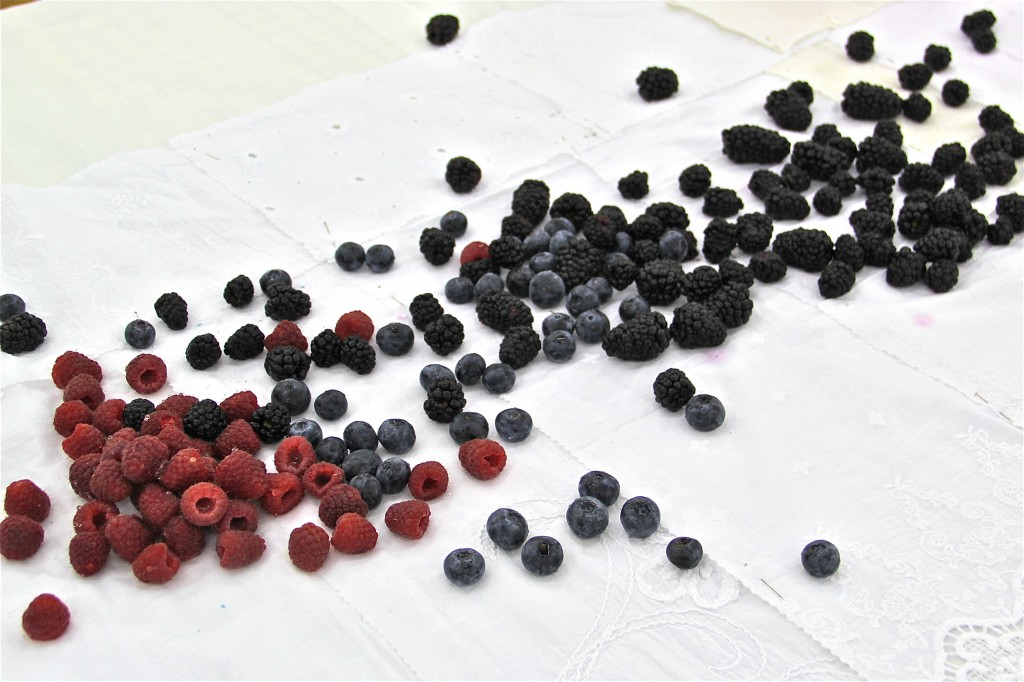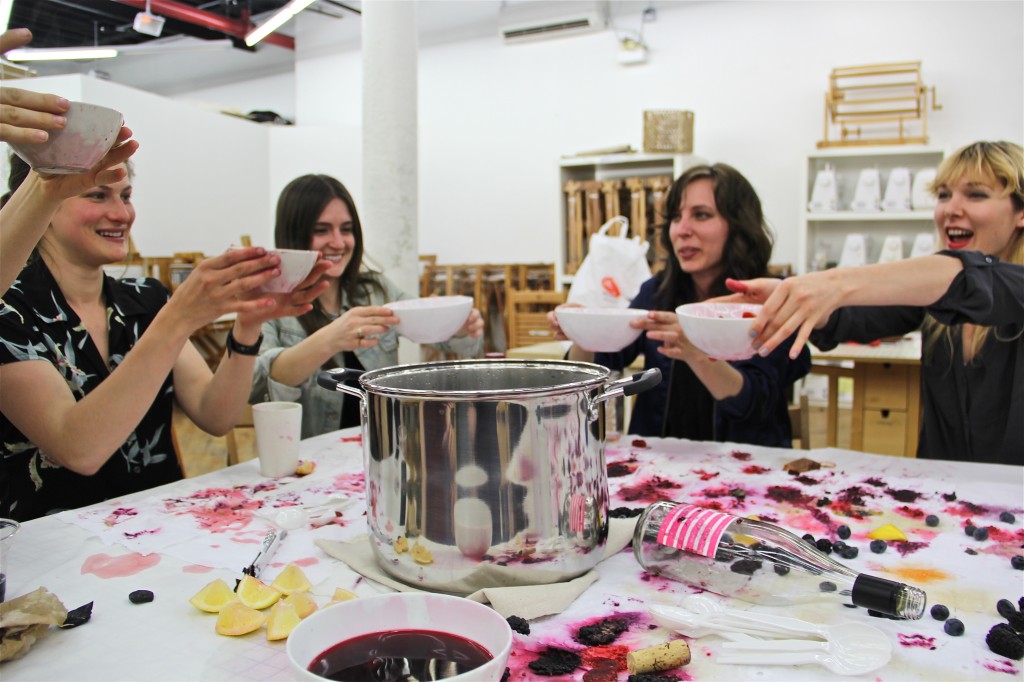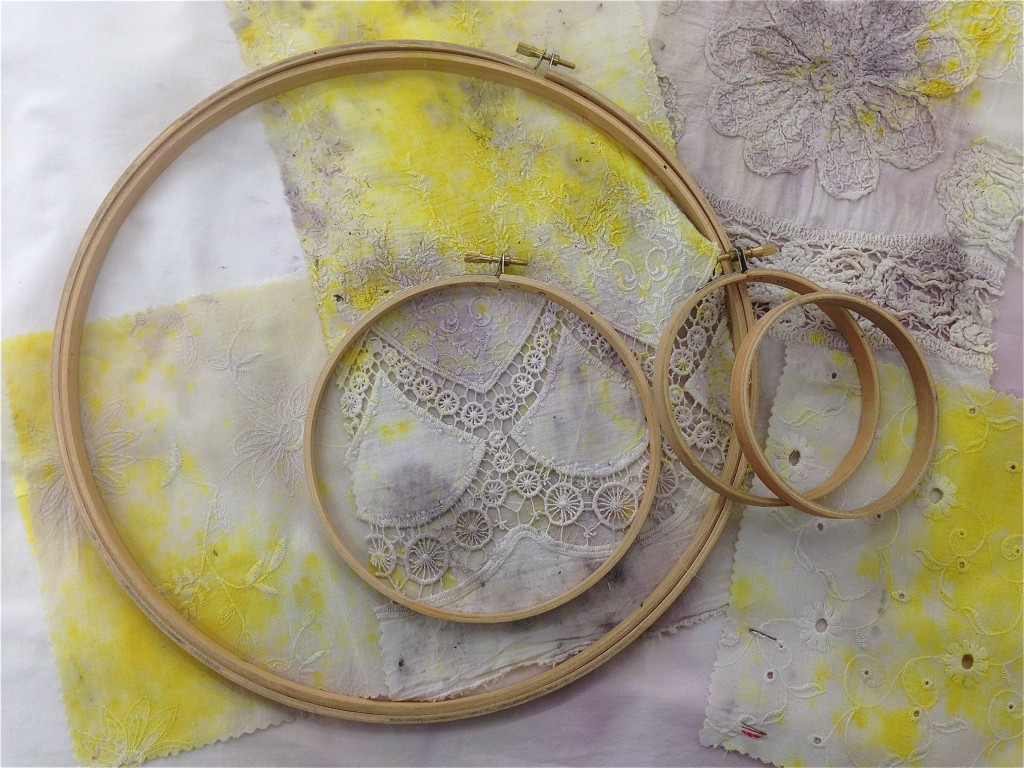What a Mess: A Stained and Stitched Tutorial
Labor—to be honest, Lynn and I struggled with this month's inspiration. As Textile Arts Center ladies, we began thinking specifically about women’s work. But how do we talk about such a loaded topic? For this tutorial, I wanted to acknowledge the history of women in textiles, but didn't want to re-affirm the association of needlework with the sphere of the feminine, especially in a trivialized way. Also, how could I direct the tone of the theme? As a challenge to traditional ideas of what labor is appropriate for women? As an appreciation of the labor that women have historically done? As a reframing of "domestic crafts" as artwork? There was so much I wanted to say, but I felt blocked on how to say it.
So, I called up the leading lady in my life, my sister, to talk it out. She was immediately there to dig in with me. We talked for a long time about women's work in textiles, both historic and contemporary, as well as the ever-present question for us as two ladies livin' in the modern day: what does it mean to identify as a woman, and take on something that we call "the feminine" as part of ourselves, while also feeling conflicted about what femininity really is?
A lot came up in our talk, but there were a few ideas that really strongly resonated with us. First, grappling with the concept of women's labor in a broader sense, we kept relating to the common role of women as those who clean up messes, both emotional and physical. The internalized expectation for order-making, perfection, and cleanliness as part of the process of "becoming a woman" felt so tied into our struggle with a certain conception of femininity and domestic craft. At the same time, the opposite—the image of the hysterical, the Fury, the chaotic—felt just as limiting. I wanted to find a way to open up a space outside the binary options of women as orderly or hysterical and also challenge the role of women as perfecters, especially in the domestic sphere.
The internalized expectation for order-making, perfection, and cleanliness as part of the process of "becoming a woman" felt so tied into our struggle with a certain conception of femininity and domestic craft.
Embroidery arose as a natural medium to respond to these issues. In The Subversive Stitch: Embroidery and the Making of the Feminine, Rozsika Parker describes embroidery as "both an instrument of oppression and an important source of creative satisfaction," frustratingly associated with "femininity, triviality and domesticity." On reading that, I felt driven to use this tool of oppression as a medium for subversion, expression, and empowerment. I also wanted to draw on the pop-culture association of needlework with idle women's talk, moving the space of the stitcher's circle from gossip to dialogue.
In an attempt to confront associations of orderliness, cleanliness, and servitude with the feminine, and move away from embroidery as a trivial decorative art, we threw a decidedly messy women's gathering. In this meeting of the minds, some of the women of TAC purposefully left stains on fabric as we dined on berries and wine and schemed together on these ideas. To reinforce the importance of this kind of meeting, and reshape the role of the needle, we later stitched around the stains left from our gathering, highlighting rather than hiding these strange, organic "mistakes."
Materials:
Fabric (we used scrap fabric we found in the studio and a few yards of mercerized cotton)
Stain-making food! (we drank wine, tea, and carrot juice, and snacked on berries and borscht made by the lovely Lynn. We also threw some turmeric in for good measure.)
Detergent
Iron
Embroidery supplies (hoops, needles, and thread)
Instructions:
Step One: Lay out your linens
Lynn found several scraps of beautiful lace-edged fabric around the studio, which we decided would be great for our stains. We began by laying a plastic tarp over our table, to protect it from the mess we were about to make. We then laid down a few yards of mercerized cotton as a tablecloth, with the lace-y scraps pinned together on top.
Step Two: Gather your ladies
We're always looking for a reason to get a bunch of Textile Arts Center ladies together, so this step was pretty easy. But generally, round up your gal-identified friends for a messy feast and a discussion of women's work.
Step Three: Throw a feast, talk about how to tear down the patriarchy
And get messy! Wine was spilled, tea cups tipped over, and berries were mashed into the tablecloth. Play around with a bunch of different stain-making food items (and remember to choose something delicious).
Step Four: Collect your linens
At the end of the night, it was time to collect all those good stains. We rolled the fabric (with newsprint between each layer) onto the bar for the steamer in TAC's studio. Just to be sure all that food and wine really bonded with our fabric, we put it in the steamer for around 45 minutes to take the natural dyes through different temperature ranges. If a large steamer isn't part of your home set-up (understandably), feel free to skip this step. Judging from some ruined shirts I have, wine can stain just fine on its own.
Step Five: Wash 'em out
Be sure to give your fabric a good wash with soap and water. Your stains will remain, and all the food bits will be gone. After our fabric was clean and dry, I ironed out each piece so I could check out the results in detail, and so they would be easier to embroider.
Step Six: Distribute to your ladies for stitching
...or create a stitching circle and embroider with them!
New to embroidery? Great! I've included instructional images for three basic stitches that allow you to do different things. Running stitch, which creates a dashed line, is probably the most familiar stitch if you already know how to hand sew. It goes fast, and quickly covers a lot of ground. Backstitch is similar to a running stitch, but creates a solid line. For this stitch, come up through your fabric a stitch length's away from where you last went down through your fabric, then loop back over and go back into the hole where your last stitch ended. Keep leap-frogging along, and you'll be able to easily make curves and specific shapes. Finally, the french knot allows you to create more texture on the surface of your work. Come up through your fabric, wrap your thread around your needle a few times, and hold the thread taught as you go right back through your first hole (or very close to it, if you find your knot slipping through).
Again, this is just a basic rundown to get you started. If you find yourself wanting to know more, check out one of our upcoming embroidery classes! I'm particularly excited for Autobiographical Embroidery with Joetta Maue.
Step Seven: Share your work with your friends! And repeat!
Check out the beautiful and varied work that TAC ladies made after our feast:
P.S. Want to make stains with the TAC community? Join us on May 22 for STAINED, an incredible, sensorial natural dye experience presented by Sewing Seeds. See you there!














